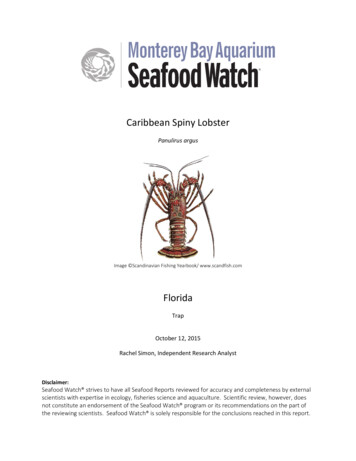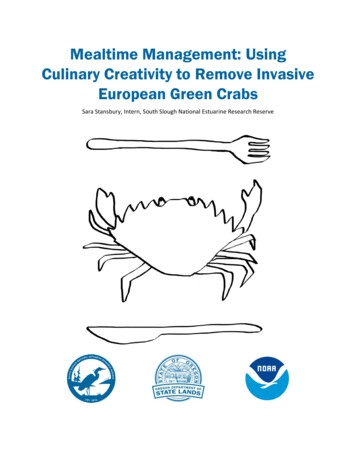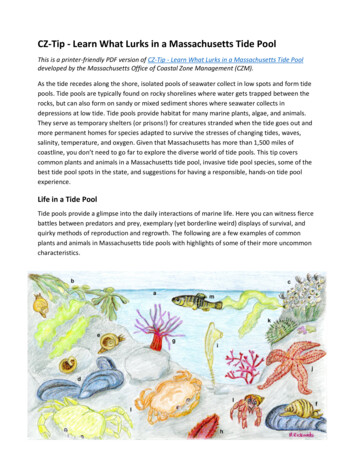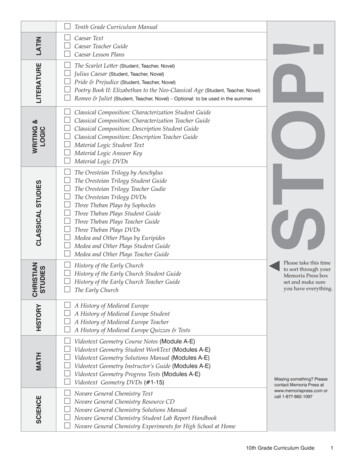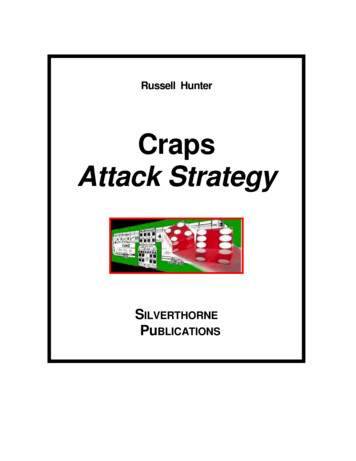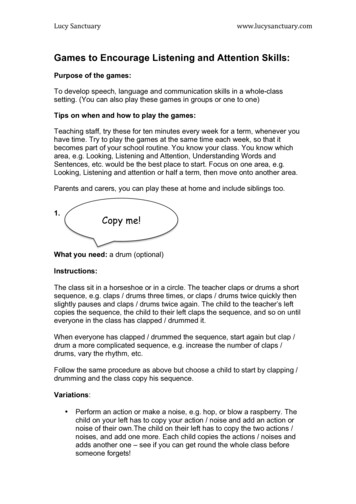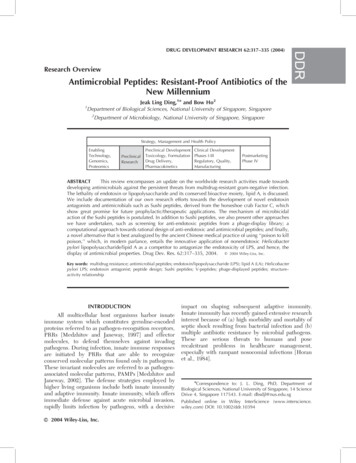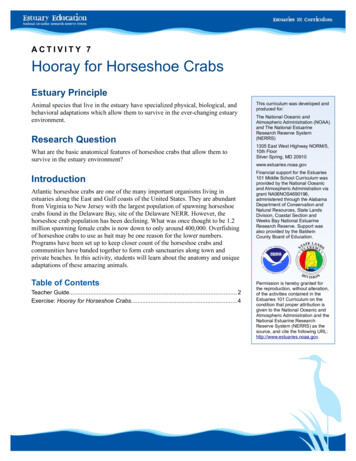
Transcription
ACTIVITY 7Hooray for Horseshoe CrabsEstuary PrincipleAnimal species that live in the estuary have specialized physical, biological, andbehavioral adaptations which allow them to survive in the ever-changing estuaryenvironment.Research QuestionWhat are the basic anatomical features of horseshoe crabs that allow them tosurvive in the estuary environment?IntroductionAtlantic horseshoe crabs are one of the many important organisms living inestuaries along the East and Gulf coasts of the United States. They are abundantfrom Virginia to New Jersey with the largest population of spawning horseshoecrabs found in the Delaware Bay, site of the Delaware NERR. However, thehorseshoe crab population has been declining. What was once thought to be 1.2million spawning female crabs is now down to only around 400,000. Overfishingof horseshoe crabs to use as bait may be one reason for the lower numbers.Programs have been set up to keep closer count of the horseshoe crabs andcommunities have banded together to form crab sanctuaries along town andprivate beaches. In this activity, students will learn about the anatomy and uniqueadaptations of these amazing animals.Table of ContentsTeacher Guide. 2Exercise: Hooray for Horseshoe Crabs.4This curriculum was developed andproduced for:The National Oceanic andAtmospheric Administration (NOAA)and The National EstuarineResearch Reserve System(NERRS)1305 East West Highway NORM/5,10th FloorSilver Spring, MD 20910www.estuaries.noaa.govFinancial support for the Estuaries101 Middle School Curriculum wasprovided by the National Oceanicand Atmospheric Administration viagrant NA06NOS4690196,administered through the AlabamaDepartment of Conservation andNatural Resources, State LandsDivision, Coastal Section andWeeks Bay National EstuarineResearch Reserve. Support wasalso provided by the BaldwinCounty Board of Education.Permission is hereby granted forthe reproduction, without alteration,of the activities contained in theEstuaries 101 Curriculum on thecondition that proper attribution isgiven to the National Oceanic andAtmospheric Administration and theNational Estuarine ResearchReserve System (NERRS) as thesource, and cite the following URL:http://www.estuaries.noaa.gov.
TEACHER GUIDEHooray for Horseshoe CrabsResearch QuestionWhat are the basic anatomical features of horseshoe crabs that allow them tosurvive in the estuary environment?Content ObjectivesStudents will understand that: Horseshoe crabs are arthropods, but are not true crabs. Horseshoe crabs are benthic or bottom dwellers. Horseshoe crabs move along the bottom of the ocean or estuary using their tenlegs. Horseshoe crabs leave the water to crawl onto the beach to lay their eggs in thesand.ExercisesHooray for Horseshoe Crabs!Students examine the form and function of different horseshoe crab anatomicalfeatures.Assessment QuestionsAssessment questions based on content covered in Hooray for Horseshoe Crabscan be downloaded on the web page for this activity in the Middle SchoolCurriculum section of the Estuary Education website at estuaries.noaa.gov.VocabularyAdaptation – adjustment to environmental conditions.Arthropod – any of a phylum (Arthropoda) of invertebrates (as insects,arachnids, and crustaceans) that have a segmented body and jointed appendages.Invertebrate – an animal without a backbone.Exoskeleton – a hard outer coveringAn extended vocabulary list of horseshoe crab anatomy is provided in theStudent Master: Hooray for Horseshoe Crabs.Activity 7: Hooray for Horseshoe Crabs2
Taking It FurtherEducate with Literature!Purchase or borrow a copy of the children’s picture book, Crab Moon by RuthHorowitz. In 2001, this book was selected by the National Science TeachersAssociation as an “Outstanding Science Trade Book.” It tells the story of amother and son who witness horseshoe crabs laying their eggs on a beach under afull moon. Before you read this story to your students, explain that you know thebook is for much younger kids, but that you have a reason for sharing the bookwith them. Read the book aloud to your students and discuss their reactions to thestory. Then coordinate a time when your students can visit elementary schoolstudents in your district and share the story with them. The power of olderstudents teaching younger students cannot be underestimated!Activity 7: Hooray for Horseshoe Crabs3
EXERCISEHooray for Horseshoe Crabs!Estuary ConceptOverviewHorseshoe crabs are adapted to live along bottoms of estuaries.In this exercise, students willread about horseshoe crabanatomical features and matchthose features to diagrams ofthe horseshoe crab.Focus Questions What are the basic characteristics of horseshoe crabs?Time Required What are the functions of the major anatomical features found in horseshoecrabs?One 45-minute class periodPerformance TasksStudents will: Identify the key characteristics of the horseshoe crab, starting with its threemain anatomical divisions. Identify the key characteristics which link this species to arthropods and nottrue crabs. Identify the horseshoe crab’s external organs, including the book gills, telson(tail), compound eyes, mouth, chelicerae and other legs. Identify the horseshoe crab’s internal organs including the brain, heart, cropand gizzard, and mid-gut.Teacher PreparationBackground information for teachers and students is contained in the Backgroundinformation sheet that accompanies the Student Master: Hooray for HorseshoeCrabs.View the Horseshoe Crabs video on the web page for this activity in the MiddleSchool Curriculum section of the Estuary Education website atestuaries.noaa.gov. This 10-minute video features Mark Maddox showing kids ahorseshoe crab up close and discussing the animal’s anatomy and importance.You'll find multimedia and otherresources on the web page forthis activity in the Middle SchoolCurriculum section of theEstuary Education website:http://estuaries.noaa.gov.Make copies of Student Master: Hooray for Horseshoe Crabs, including theBackground information sheet and the four horseshoe crab diagrams students willbe labeling in the exercise.You may want to duplicate the color photos of horseshoe crab models found onthe Teacher Masters. Projecting these for your class will make it easier to discussthe horseshoe crab’s anatomy and for your students to check whether or not theirdiagrams are labeled correctly.Procedure1. To begin this exercise, show students the Horseshoe Crabs video that youwill find on the web page for this activity in the Middle School Curriculumsection of the Estuary Education website at estuaries.noaa.gov.Activity 7: Hooray for Horseshoe Crabs4
2. Distribute copies of Student Master: Hooray for Horseshoe Crabs. Be sure toinclude the Background information sheet as well as the four horseshoe crabdiagrams.3. You may want students to read the Background information as homework thenight before the activity. If you do, give students the Background informationsheet to take home and read, but don’t give them the Student Master and thefour horseshoe crab diagrams until it is time for them to do the activity inclass.MaterialsPer studentStudent Master: Hooray forHorseshoe Crabs including theBackground information sheetand the four horseshoe crabdiagrams4. Students use information from the Student Master, the Backgroundinformation sheet, and the clues on the horseshoe crab diagram sheets tolabel the diagrams with the 16 body parts listed on the Student Master.5. Review student choices of diagram labels by duplicating the four TeacherMasters and projecting them in front of your class. These show color modelsof the same horseshoe crab anatomy as shown in the diagrams students havelabeled.6. Students then answer the questions on the Student Master. Possible studentanswers to the questions are provided below.Questions and Possible AnswersQ1. What are the three main divisions of the horseshoe crab called?The three main divisions of the horseshoe crab are the prosoma, theopisthosoma, and the telson.Q2. How do horseshoe crabs move? How is that different from fish, birds,and humans?Horseshoe crabs use five of their six pairs of legs to walk or push themselvesforward along the bottom of water bodies such as bays and up onto beachesto spawn. Humans and many types of birds use their legs to walk in and outof the water. Fish do not have legs; they swim.Q3. Why are horseshoe crabs considered to be arthropods? Why are they inthe class Merastomata?Arthropods are segmented (or jointed) invertebrates with exoskeletons.Horseshoe crabs have three segments: the prosoma; the opithosoma; and thetelson or tail. Horseshoe crabs are in the class Merastomata because theirmouth is surrounded by the bases of their legs.Q4. Where does the horseshoe crab begin its life and how does it grow?Spawning takes place on the beach, out of the water. Female horseshoe crabslay their eggs on the beach along the ocean or bay. Eggs that survive hungryshorebirds hatch in about four weeks. As the crab grows, it must molt. Thismeans it sheds its hard shell (an exoskeleton called a carapace) and grows anew, larger shell. The horseshoe crab must molt many times until it becomesan adult.Activity 7: Hooray for Horseshoe Crabs5
TEACHER MASTERHorseshoe Crab featuresProsomaCompound eyeOpisthosomaCrop & GizzardEggsTelsonBrainMid-gutPhoto: Ecological Research & Development Group Inc. www.horseshoecrab.orgActivity 7: Hooray for Horseshoe Crabs6
TEACHER MASTERHorseshoe Crab r legsBook gillsOperculumPhoto: Ecological Research & Development Group Inc. www.horseshoecrab.orgActivity 7: Hooray for Horseshoe Crabs7
STUDENT MASTERHooray for Horseshoe CrabsHorseshoe CrabPhoto: Ecological Research &Development Group Inc.Blue CrabSpiderPhoto: Mary Hollinger,NODC biologist, NOAAPhoto: Brooke Vallaster,NOAA, Sapelo Island NERRWhen is a crab not a crab? Like other crabs, horseshoe crabs are arthropods. But so are spiders and scorpions. They allhave exoskeletons, a body divided into segments, and legs with joints. But horseshoe crabs are not true crabs. Theydon’t belong to the same class, Crustacea, as the blue crab and other crabs. True crabs have antennae, jaws, and onlyfive pairs of legs. Horseshoe crabs don’t have antennae or jaws and have six pairs of legs. Horseshoe crabs are in aclass of their own: Merastomata, which means “mouth surrounded by legs.Horseshoe crab fossils, similar in form to the ones you see in estuaries today, are found in rocks over 450 millionyears old. In this exercise, you are going to take a closer look at the anatomy of this ancient creature.Procedure1. Read the Background information sheet about horseshoe crab anatomy.2. Read the clues on the four horseshoe crab diagrams (view of the top and bottom, external features and internalorgans). Label the diagrams with the following features based on the clues and the information on the Backgroundinformation sheet.EggsCompound eyeProsomaCrop & rteriesPusher legsHeartOperculumBook gillsOpisthosoma3. When you have finished labeling the horseshoe crab diagrams, answer the following questions.QuestionsQ1. What are the three main divisions of the horseshoe crab called?Q2. How do horseshoe crabs move through the water? How is that different than fish, birds, and humans?Activity 7: Hooray for Horseshoe Crabs8
Q3. Why are horseshoe crabs considered to be arthropods? Why are they in the class Merastomata?Q4. Where does the horseshoe crab begin its life and how does it grow?Activity 7: Hooray for Horseshoe Crabs9
STUDENT MASTERBackground: Horseshoe Crab AnatomyThe horseshoe crab’s body is divided into three sections. The front section is called the prosoma. The middle sectionis called the opisthosoma. And the horseshoe crab’s tail is called the telson. While the telson may look dangerous, thecrab mainly uses it for digging and to help turn itself back over if it gets flipped over on the beach. The telson is veryfragile. Horseshoe crabs should never be picked up by their tails.Horseshoe crabs are benthic animals, meaning that they normally live along the seafloor or bottom of an estuary’s bayor lagoon. Horseshoe crabs move underwater along the bottom or out of the water along the flat beach by using theirfive pairs of jointed legs. The fifth pair of larger pusher legs, found nearer the tail, is used to push the animal forward.Respiratory SystemLike many other aquatic animals, horseshoe crabs breathe through gills. They have six pairs of gills along the bottomof the opithosoma. These are called book gills because they look like pages in a book. The first pair of book gills iscalled the operculum, which helps protect the other gills and covers the opening of the pore through which the crabreleases either eggs or sperm.Circulatory SystemHorseshoe crabs have a long, tube-like heart that runs the length of their body (not the tail). It beats about 32 timesper minute, pumping the horseshoe crab’s blue blood through arteries and out into the rest of the crab’s body.Digestive SystemHorseshoe crabs eat small bivalves, mollusks, fish, worms, and algae. The horseshoe crab’s legs are covered withbristles that grind up the food as the crab walks, eventually pushing it toward the crab’s mouth, which is located at thepoint where all the legs meet. Two of those legs, called chelicerae, are not used for movement at all but rather forpushing food into the horseshoe crab’s mouth. Food that enters the mouth is first ground up in the crop and gizzardbefore passing into the mid-gut, which is where the food is finally digested.Nervous SystemThe horseshoe crab’s brain rests in the middle of the prosoma. Nerves run from the brain to the rest of the body,including to the horseshoe crab’s many eyes. The horseshoe crab has two compound eyes on the top of the prosoma.These eyes have many lenses, making them similar to the eyes of a housefly. There are five other eyes on the top ofthe horseshoe crab and two eyes near the mouth on the crab’s bottom. There are also light-sensitive photoreceptors onthe horseshoe crab’s tail.Life CycleHorseshoe crabs live in the water, but come up onto the sandy beach to reproduce. The male horseshoe crab is usuallyabout one-third the size of the female. The male has two “boxing glove” like claws on its first set of walking legs.These specialized legs are called pedipalps and allow the male to hold onto the female during spawning. The femalehorseshoe crab is said to be larger than the male in order to hold a vast number of eggs within her body. Females laybetween 80,000 and 100,000 eggs in the sand during one spawning season. The eggs are about 1.5 mm (1/16 inch) indiameter and greenish tan in color. Fertilization of the eggs occurs outside of the body while the female is burying theeggs on the beach.Horseshoe crabs begin their lives as eggs buried in the sand on a beach. Many of the horseshoe crab eggs getuncovered and eaten by birds. Those that aren’t eaten are left to incubate in the sand. In about four weeks, babyhorseshoe crabs emerge from the eggs. Horseshoe crabs are like other animals with exoskeletons. As it grows, theActivity 7: Hooray for Horseshoe Crabs10
horseshoe crab outgrows its shell, called a carapace. The crab molts, leaving its old shell behind and growing a new,larger shell. A horseshoe crab will molt 16 to 18 times over a period of about 10 years until it reaches adulthood.Horseshoe crabs can live to be about 20 years old if they do not get eaten by predators, get stranded on the beach,become injured, or get a disease.Activity 7: Hooray for Horseshoe Crabs11
STUDENT MASTERHorseshoe Crab: External features (top view)These might be themost obvious, butthe horseshoe crabhas 5 additional eyeon its top, 2 on itsbottom, plus lightsensors along the topand bottom of itstail.The "head" sectionof the horseshoe crabcontains much of thecrab's nervous anddigestive system,plus the muscles tomove its legs.The horseshoe crab'smiddle sectionmostly contains themuscles needed tomove its tail and tobreathe.Less scary than itlooks, the crabcan use this toflip itself over if itgets turned overon its back.Activity 7: Hooray for Horseshoe Crabs12
STUDENT MASTERHorseshoe Crab: External features (bottom view)This first pair of walkinglegs is also used by themale during spawning.The start of the crab'sdigestive tract islocated where all thelegs come together.Crabs have tobreathe and they getoxygen when watercirculates throughthe "pages" of thesefeatures.More like arms thanlegs, these are usefulfor getting food intothe crab's mouth.When it comes timeto move, the last pairof legs gets the crabscuttling across thesand.This covers the othergills and theopening throughwhich the crabreleases eggs orsperm.Activity 7: Hooray for Horseshoe Crabs13
STUDENT MASTERHorseshoe Crab: Internal features (top view)The horseshoe crab'sblood leavesthrough these tubes,eventually goinginto the book gills toget oxygen beforereturning to theheart.This circulatory organextends almost theentire length of thehorseshoe crab's bodyand beat 32 times perminute.Activity 7: Hooray for Horseshoe Crabs14
STUDENT MASTERHorseshoe Crab: Internal features (bottom view)Near the beginning of thehorseshoe crab's digestivetract, these parts gather thefood together and grind it toa pulp.An adult femalehorseshoe crab canlay over 80,000 ofthese each year.Like other animals, thisorgan is the center of thehorseshoe crab's nervoussystem.Pulverized food passesinto this part of thehorseshoe crab to bedigested.Activity 7: Hooray for Horseshoe Crabs15
The horseshoe crab’s body is divided into three sections. The front section is called the prosoma. The middle section is called the opisthosoma. And the horseshoe crab’s tail is called the telson. While the telson may look dangerous, the crab mainly uses it for digging and to help turn itself back ov
